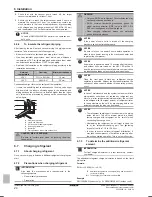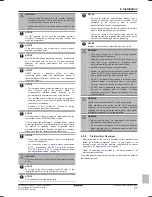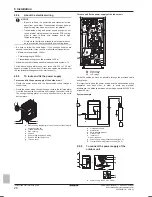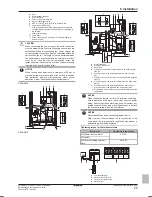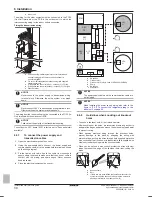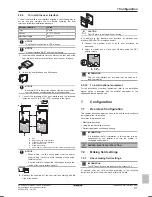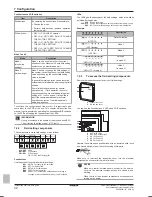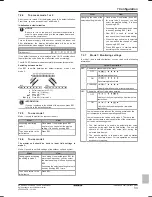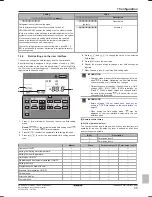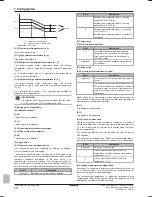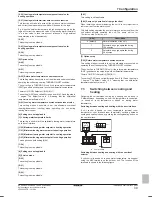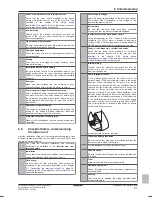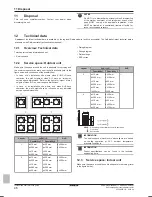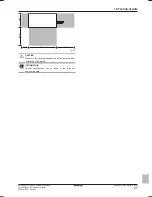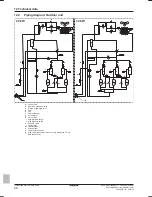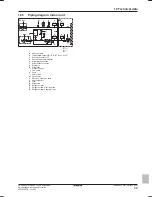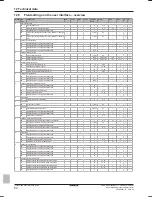
7 Configuration
Installer and user reference guide
38
SERHQ020~0 SEHVX20~64BAW
Split packaged air-cooled water chiller
4P508020-1B – 2018.04
Lo_Ti
Lo_A
Hi_A
T
A
T
t
+ 05
00
– 05
Hi_Ti
Shift value
T
t
Target water temperature
T
A
Ambient (outdoor) temperature
Shift value
Shift value
[3‑00] Low ambient temperature (Lo_A)
Low outdoor temperature.
[3‑01] High ambient temperature (Hi_A)
High outdoor temperature.
[3‑02] Setpoint at low ambient temperature (Lo_Ti)
The target outgoing water temperature when the outdoor
temperature equals or drops below the low ambient temperature
(Lo_A).
Lo_Ti should be higher than Hi_Ti, as warmer water is required for
colder outdoor temperatures.
[3‑03] Setpoint at high ambient temperature (Hi_Ti)
The target outgoing water temperature when the outdoor
temperature equals or rises above the high ambient temperature
(Hi_A).
Hi_Ti should be lower than Lo_Ti, as less warm water suffices for
warmer outdoor temperatures.
INFORMATION
If the value of [3‑03] is mistakenly set higher than the value
of [3‑02], the value of [3‑03] will always be used.
[4] Settings are not applicable
[5] Automatic setback
[5-00]
This setting is not applicable.
[5-01]
This setting is not applicable.
[5‑02] Leaving water setback temperature
[5‑03] Room setback temperature
[5-04]
This setting is not applicable.
[6] Option setup
[6‑01] External room thermostat option
If an optional external room thermostat is installed, its operation
must be enabled by this field setting.
The external room thermostat only gives an ON/OFF signal to the
heat pump based on the room temperature. Because it does not give
continuous feedback information to the heat pump, it is
supplementary to the user interface room thermostat function. To
have a good control of the system and avoid frequent ON/OFF it is
advised to use the automatic weather dependent setpoint operation.
[6‑01]
Description
0 (default)
External room thermostat not installed.
[6‑01]
Description
1
External room thermostat input 1 = heating
operation ON (1)/OFF (0).
External room thermostat input 2 = cooling
operation ON (1)/OFF (0).
2
External room thermostat input 1 = operation
ON (1)/OFF (0).
External room thermostat input 2 = cooling (1)/
heating (0).
[7] Option setup
[7‑00] Forced pump operation
[7‑00]
Description
0
The pump performs intermittent sampling
during thermo off conditions. This setting is
often used when the unit is controlled by a
room thermostat.
1 (default)
The pump continues operation during thermo
off conditions.
[8] Option setup
[8‑00] User interface temperature control
[8‑00]
Description
0 (default)
The unit operates in leaving water temperature
control.
1
The unit operates in room temperature control.
This means that the user interface is used as a
room thermostat, so the user interface can be
placed in the living room to control the room
temperature.
Note:
When the unit is operated in room temperature control (by
user interface or external room thermostat option), room temperature
has priority over leaving water setpoint.
[8-01]
This setting is not applicable.
[8-03]
This setting is not applicable.
[8‑04] Freeze-up prevention
Freeze-up prevention will be activated by starting up the pump to
circulate the water, and if the leaving or return water temperature is
<5°C for 5 minutes, the unit will start up in heating mode to prevent
too low temperatures.
The freeze-up prevention is only active when the unit is in thermo
OFF condition.
The option can be enabled when there is no optional heater tape or
glycol in the system and when heat can be used from an application.
[8‑04]
Description
0 (default)
No freeze-up prevention
1
Freeze-up prevention level 1 (outdoor
temperature <4°C and leaving or return water
temperature <7°C)
2
Freeze-up prevention level 2 (outdoor
temperature <4°C)
[9] Automatic temperature compensation
If necessary, it is possible to adjust some thermistor value of the unit
by a correction value. This can be used as countermeasure for
thermistor tolerances or capacity shortage.
The compensated temperature (= measured temperature plus
compensation value) is then used to control the system and will be
displayed in the temperature read-out mode.

